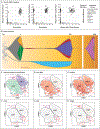Immune Escape of Relapsed AML Cells after Allogeneic Transplantation
- PMID: 30380364
- PMCID: PMC6322675
- DOI: 10.1056/NEJMoa1808777
Immune Escape of Relapsed AML Cells after Allogeneic Transplantation
Abstract
Background: As consolidation therapy for acute myeloid leukemia (AML), allogeneic hematopoietic stem-cell transplantation provides a benefit in part by means of an immune-mediated graft-versus-leukemia effect. We hypothesized that the immune-mediated selective pressure imposed by allogeneic transplantation may cause distinct patterns of tumor evolution in relapsed disease.
Methods: We performed enhanced exome sequencing on paired samples obtained at initial presentation with AML and at relapse from 15 patients who had a relapse after hematopoietic stem-cell transplantation (with transplants from an HLA-matched sibling, HLA-matched unrelated donor, or HLA-mismatched unrelated donor) and from 20 patients who had a relapse after chemotherapy. We performed RNA sequencing and flow cytometry on a subgroup of these samples and on additional samples for validation.
Results: On exome sequencing, the spectrum of gained and lost mutations observed with relapse after transplantation was similar to the spectrum observed with relapse after chemotherapy. Specifically, relapse after transplantation was not associated with the acquisition of previously unknown AML-specific mutations or structural variations in immune-related genes. In contrast, RNA sequencing of samples obtained at relapse after transplantation revealed dysregulation of pathways involved in adaptive and innate immunity, including down-regulation of major histocompatibility complex (MHC) class II genes ( HLA-DPA1, HLA-DPB1, HLA-DQB1, and HLA-DRB1) to levels that were 3 to 12 times lower than the levels seen in paired samples obtained at presentation. Flow cytometry and immunohistochemical analysis confirmed decreased expression of MHC class II at relapse in 17 of 34 patients who had a relapse after transplantation. Evidence suggested that interferon-γ treatment could rapidly reverse this phenotype in AML blasts in vitro.
Conclusions: AML relapse after transplantation was not associated with the acquisition of relapse-specific mutations in immune-related genes. However, it was associated with dysregulation of pathways that may influence immune function, including down-regulation of MHC class II genes, which are involved in antigen presentation. These epigenetic changes may be reversible with appropriate therapy. (Funded by the National Cancer Institute and others.).
Figures




Comment in
-
Immune Escape of AML Cells after Transplantation.N Engl J Med. 2019 Mar 28;380(13):1289. doi: 10.1056/NEJMc1900424. N Engl J Med. 2019. PMID: 30917271 No abstract available.
-
Immune Escape of AML Cells after Transplantation.N Engl J Med. 2019 Mar 28;380(13):1289. doi: 10.1056/NEJMc1900424. N Engl J Med. 2019. PMID: 30917272 No abstract available.
References
-
- Weiden PL, Sullivan KM, Flournoy N, Storb R, Thomas ED, Seattle Marrow Transplant Team. Antileukemic effect of chronic graft-versus-host disease — contribution to improved survival after allogeneic marrow transplantation. N Engl J Med 1981; 304: 1529–33. - PubMed
-
- Weiden PL, Flournoy N, Thomas ED, et al. Antileukemic effect of graft-versus-host disease in human recipients of allogeneic-marrow grafts. N Engl J Med 1979; 300: 1068–73. - PubMed
-
- Mielcarek M, Storer BE, Flowers MED, Storb R, Sandmaier BM, Martin PJ. Outcomes among patients with recurrent high-risk hematologic malignancies after allogeneic hematopoietic cell transplantation. Biol Blood Marrow Transplant 2007; 13: 1160–8. - PubMed
-
- Pollyea DA, Artz AS, Stock W, et al. Outcomes of patients with AML and MDS who relapse or progress after reduced intensity allogeneic hematopoietic cell transplantation. Bone Marrow Transplant 2007; 40: 1027–32. - PubMed
Publication types
MeSH terms
Substances
Grants and funding
LinkOut - more resources
Full Text Sources
Other Literature Sources
Medical
Molecular Biology Databases
Research Materials
